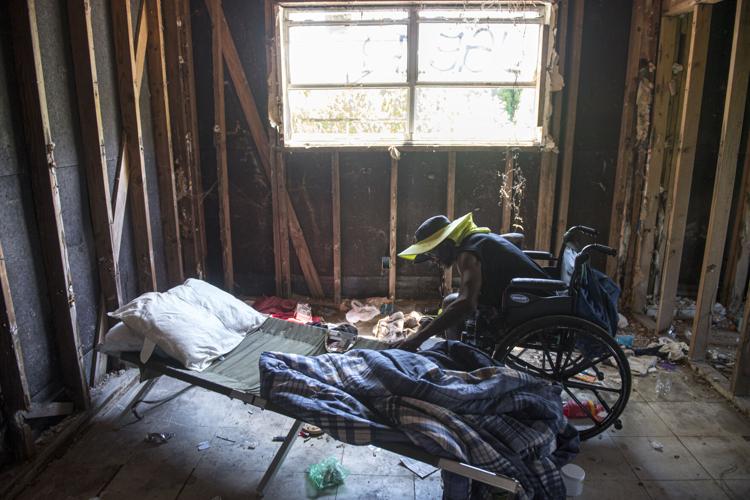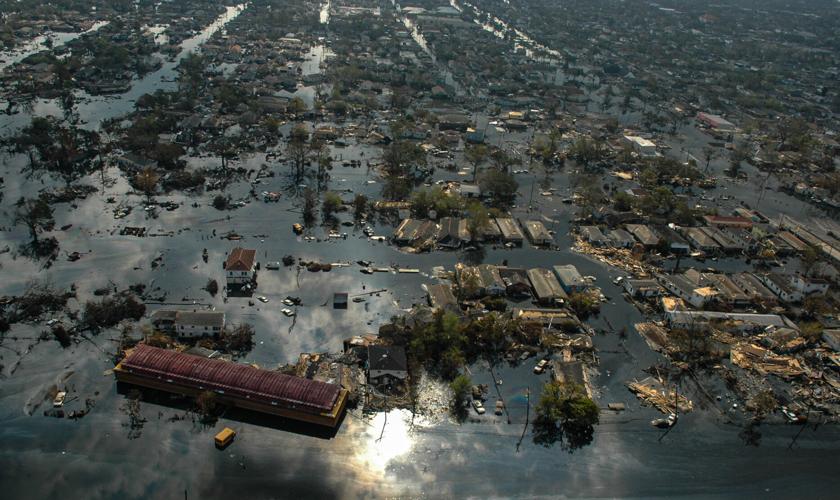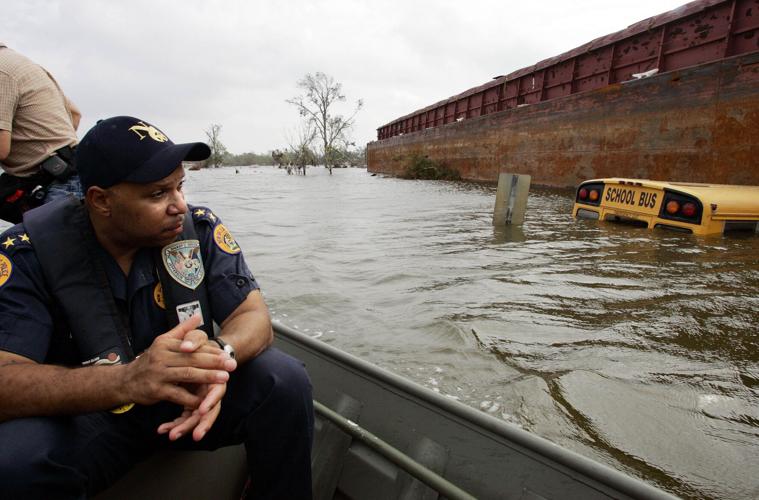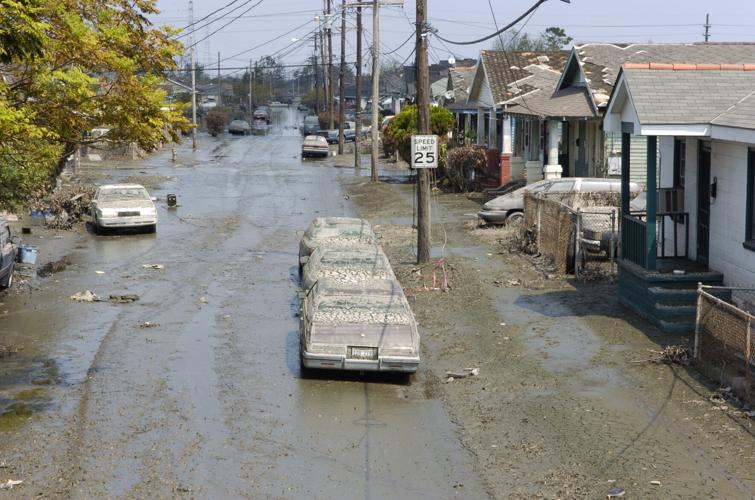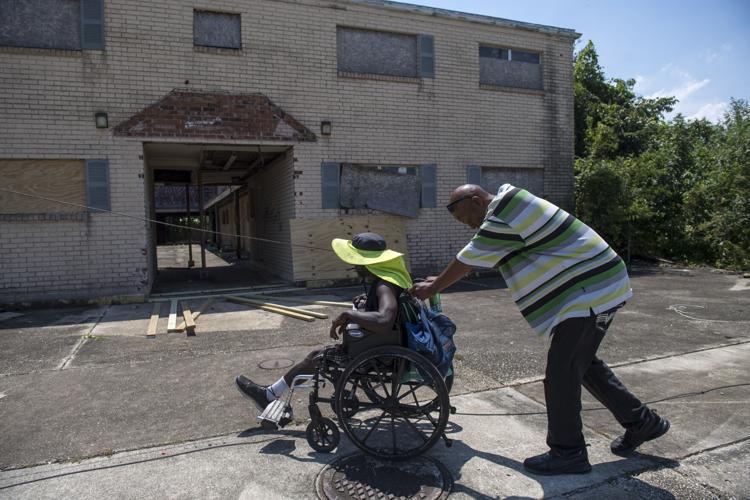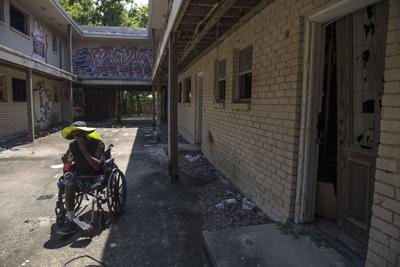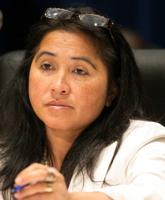Kent Montgomery settled in for bad weather last week under a roof in the Lower 9th Ward that’s been gashed since 2005.
He slept on a metal cot, surrounded by bare wall studs, dangling wires, spiderwebs and shattered glass, in a gutted brick apartment building on North Derbigny Street.
He awoke one recent morning and backed his wheelchair through a swarm of bees into a courtyard dotted with graffiti and trash. Doctors amputated his left leg two years ago, said Montgomery, 61. Another set of scars runs down his right knee.
“Twenty-two trap. I took a lick from the blind side,” he said, describing a play and an injury he dated to a college game, after attending Francis T. Nicholls, the neighborhood high school later renamed for Frederick Douglass.

Kent Montgomery at an abandoned apartment complex in the Lower 9th Ward of New Orleans on Friday, August 21, 2020.
Montgomery has taken plenty of licks since: repeated drug convictions, years in prison, runs through homeless shelters, a lost leg.
Low on options, he returned to the Lower 9th Ward, and familiar surroundings.
“I love my neighborhood,” he said. “They know me.”
Chicken vs. egg
Grim hideouts like this one are plentiful across a Lower 9th Ward that 15 years ago became a world symbol for poverty, neglect and utter devastation, and since has shown few signs of a rebound.
Overgrown lots still blanket the landscape in the “backatown” area lakeward of North Claiborne Avenue, where the market for homes has flatlined.
Houses here continue to cost far more to build than they sell for, so much so that $75,000 in subsidies are often needed to bridge the gap in some areas, said Seth Knudsen, planning director for the New Orleans Redevelopment Authority.

The Lower Ninth Ward of New Orleans is under water during Hurricane Katrina. (Staff photo by David Grunfeld, The Times-Picayune)
But there is a citywide demand for low-income housing, which is where developers working with NORA, and others, have turned much of their focus in the Lower 9th Ward.
Critics fear a downshift in the aspirations for a revival of a neighborhood developed in the 1940s and 50s that had a jaw-dropping rate of homeownership and a population that was 98% Black when Katrina struck.
Brenda Breaux, NORA’s executive director, argues that the neighborhood must address “a chicken-and-egg problem” in a desert for services, such as a supermarket.
“That portion of the Lower Ninth Ward that didn’t come back, and hasn’t come back, that’s the reality of where we are. We are rebuilding a neighborhood,” Breaux said. “We’re talking about how to get more rooftops in an area and a community that fulfills all the things everyone wants to see.”
Gwendolyn Guice, for one, wouldn’t mind seeing less wildlife.
“I have to throw mothballs down to keep the snakes away,” she said.

Kent Montgomery at an abandoned apartment complex in the Lower 9th Ward of New Orleans on Friday, August 21, 2020.
It was hardly so rural or weed-infested when Guice, 73, bought into the neighborhood four decades ago, raising her three children in a house that would sit under 18 feet of water in Katrina.
Guice had barely made it to Texas when she resolved to come back. “I hate Houston right now today,” she said.
A patchwork recovery
In 2007, she and her next-door neighbor, Josephine Butler, became the first Lower 9th Ward residents to move home into new houses, both built by ACORN on their deserted street. Soon, another neighbor joined them. One more came home. The 2300 block of Delery Street had a quorum.
But then no one else did come back, Guice said. Another neighbor was planning a return, but died first. One by one, the three neighbors who had joined her back home passed. Butler died in 2015.
Guice’s daughter, Karonda Williams, moved three years ago to a spot just beyond Jackson Barracks in St. Bernard Parish. Guice said what keeps her on Delery Street are the memories. The house had to be stripped down and re-drywalled a few years ago.
There could be another layer to the pain, suffering and destruction wrought by Hurricane Laura this year: the toll the still-active coronaviru…
“We are homeowners. That’s the reason I thought they would come back,” she said. “They said they was gonna build up everything, and da-da-da, and they didn’t do nothing. I think they took all the money that they promised to put down here and put it Uptown. Didn’t put it down here. Because the streets been falling apart down here.”
Just about every home that gets built in the neighborhood is still subsidized, one way or another, Knudsen said. NORA offers up the land in many cases at a steep discount, from a glut of more than 500 properties it owns here, many of them sold off to the state’s Road Home program by former residents who walked away.
The federal rebuilding program was found to have discriminated in its funding formula against claimants in depressed areas like the Lower Ninth Ward. The formula pegged the payout to home value, rather than the cost to rebuild, leaving many people here well short of the money they’d need for a house.
That was one among many well-chronicled roadblocks for Lower 9th Ward residents trying to make it back. Most still have not.

David Mitchell a paramedic with Guardian EMS checks Greg Farteberry's legs while his friend Eric Charles holds his hand Tuesday August 30, 2005 on the roof of a destroyed home in the Lower 9th Ward in New Orleans La. Farteberry broke his ankle Monday morning as Hurricane Katrina tore through southeastern Louisiana. Farteberry spend most of the day monday in a tree and the night on the roof until he was rescued early Tuesday. (Staff photo by Arthur Lauck, The Advocate)
As recently as 2018, the neighborhood’s population stood at about a third of its pre-Katrina levels, with fewer than 5,000 residents, according to U.S. Census estimates.
There were 4,820 households in the Lower 9th Ward in 2000, five years before Katrina. Five years after the storm, the census logged 1,060 households. More recent estimates place the number at about 1,675, according to an analysis by The Data Center.
Tangled succession issues continue to plague numerous properties that have sat idle for years.
For NORA, that has meant development of enclaves of houses in areas where the agency has managed to aggregate enough lots, such as along Andry Street, lakeward of Claiborne, where houses line the block.

Devastation in the Lower Ninth Ward. (Staff photo by Ellis Lucia, The Times-Picayune)
For longtime homeowners like Freddie Ross, it spells an eyesore.
“That right there is real, real irritating. I’m sick of looking at it. Katrina’s been, what, 15 years? It’s a damper on my day,” he groused from his porch on Tupelo Street.
Across the street rose a cloud of brush that blotted out the house facing his neatly manicured compound. Ross, 63, expanded after the storm, buying the properties on either side of him through the popular “Lot Next Door” program. He’d been tending to those lawns anyway while they sat.
“I went to a lot of meetings about rebuilding,” he said. “They come with broken promises.”
Managing expectations
On a recent drive through the Lower 9th Ward, City Councilwoman Cyndi Nguyen offered a scorched-earth proposal as she slowly passed dump sites, tire piles and empty lots choked by weeds along streets shrouded in overgrowth near Florida Avenue.
“You know what I really want to do with all this? Burn it down,” she said.
Not all of it, Nguyen clarified. She didn’t mean, for instance, the nearby Sankofa Nature Trail and Wetland Park -- a post-Katrina restoration project that offers peace from an urban bustle somewhere else.

NOPD SWAT officers Sgt. Todd Morrell left and Lt. Cris Mandry right, help a man in the lower ninth ward out of his attic into a waiting boat after New Orleans is hit by Hurricane Katrina in New Orleans on Monday August 29, 2005. (Staff photo by Alex Brandon, The Times-Picayune)
Then she turned back from Florida Avenue, a haven for illegal dumps.
“Look at this lot right here. If I want to buy it by auction, buy the tax lien – which is probably high – then I still gotta invest probably about $40,000 to get the land clear,” she said. “Now if you burn it down – controlled burn – it’s a way of really getting things going.”
Nguyen, a first-term councilwoman from New Orleans East who worked for Road Home after the storm, said city fire officials balk at her plan. In the meantime, she’s pushing a resolution, urged by developers, to free up narrow lots by removing a driveway requirement in the neighborhood on the lakeside of Claiborne Avenue.

Claiborne Ave. in the Lower Ninth Ward during Hurricane Katrina. (Staff photo by David Grunfeld, The Times-Picayune)
“I want to change the neighborhood according to people that live out here now, not based on people that used to live out here,” Nguyen said.
“I think people out here would love to have a little bit more people out here. Some green space where their children can play. Small little delis in between these neighborhoods. I’m saying burn it down so we could entice people to do something.”
The recent closing of a CVS pharmacy that opened to fanfare in 2016 on North Claiborne didn’t shock too many residents.
“Every time I went in there the only person in there was me and an employee,” said Lisa Lemieux as she swept a broom across the narrow walkway in front of her house on Egania Street, which she bought in 2003.
New Orleans City Councilwoman Cyndi Nguyen was included in Time Magazine's "31 People Who Are Changing the South," which noted Nguyen's electi…
Lemieux pointed to an abandoned house on North Robertson, a gray wooden shell. Her friend Floyd, the "godfather" of the block, had lived there. He’d put on a new roof after Katrina, but died soon after Hurricane Isaac in 2012, she said.
“The old values are gone, because the older people don’t live here anymore,” she said. “It’s more like a new neighborhood starting over.”
Nguyen favors a gut-check on expectations for commerce in the Lower 9th Ward.
“I’ll be candid -- having Wal-Mart come to the neighborhood, it ain’t gonna happen,” she said. “The concept of even like a Raising Cane’s, I don’t think it’s going to happen.”
Nguyen cited local tastes for the latter.
“This is just a reality OK, and this is not putting anybody down: I think people in the Lower Nine like those greasy fried chicken [places],” she said.

The Lower Ninth Ward in New Orleans after Hurricane Katrina caused the levees to fail and the city was flooded. September 9, 2005. (Staff photo by Kathy Anderson, The Times-Picayune)
“I don’t like to have conversations just to sugarcoat people and say, ‘Yeah, we can get a Raising Cane’s,’ when you know very well that people here like those chicken, those fried chicken...You can’t ask people to start up a business and not be able to make money.”
Meanwhile, Nguyen said she’s pushing a plan to have “Black Lives Matter” painted in huge letters on St. Claude Avenue, outside a civil rights center that broke ground at the old McDonogh 19 Elementary School a few days before the pandemic struck in March.
Affordable housing is planned above a museum and anti-racism center at a site where a 6-year-old Leona Tate walked up the steps to help desegregate New Orleans schools one morning in 1960, amid racist jeers from the street. Tate is a co-owner of the project.
The devotion to honoring the neighborhood’s tortured history and musical culture endures, along with a crumpled infrastructure.
In November 1960, 6-year-old Leona Tate walked up the front steps of the all-white McDonogh 19 Elementary School in the Lower 9th Ward and hel…
Lately, municipal crews have been digging up numerous cockeyed, neglected streets along the Industrial Canal and farther downriver. The “full-depth” reconstruction project, funded by FEMA, promises new water and sewer lines, sidewalks, curbs.
But the direction she sees in redeveloping them -- and talk of burning debris-riddled lots -- doesn’t sit too well with Laura Paul, executive director of lowernine.org, a bootstrap nonprofit that has rebuilt 89 houses for pre-Katrina residents since 2012.
Paul said she still fields calls from people seeking help getting back. She argues that private and non-profit builders are sacrificing the neighborhood and its legacy by providing cheap rentals, buttressed in some cases by low-income housing tax credits on one end, and guaranteed market rental rates on the other.
“The reason that it’s owned by NORA at all is because of a discriminatory federally funded program,” she said.

Lower Ninth Ward resident James Ackerson, left, with friends, helped rescue of their fellow residents in the Lower Ninth Ward during Hurricane Katrina. (Staff photo by David Grunfeld, The Times-Picayune)
Paul is particularly critical of New Orleans Area Habitat for Humanity, one of four steady contractors participating in a long-running plan with NORA to build scores of new homes in the neighborhood.
“It can’t just be, ‘Let’s get this property back into commerce.’ It has to be meaningful and mindful and respectful of the community, and none of this is respectful of the community,” Paul said.
“How can you talk about affordable housing as a priority while you are keeping Black families in poverty?”
A 'conscious decision'
Habitat, the nonprofit homebuilder, is more than a year into a five-year plan to build 16 doubles and 48 single-family homes in the neighborhood on lots in NORA’s inventory. The goal is a mix of owner housing and rentals, not unlike what existed before the storm, said executive director Marguerite Oestreicher.
“We made a conscious decision when we started working on this to frontload with rentals. It’s a faster way to build density. We need families, need children for schools, enough people to support stores,” she said. “I think everybody thought it would happen faster.”
New Orleans Area Habitat for Humanity dedicated two new homes in the Lower Ninth Ward on June 2 from its second annual Women Build.
Oestreicher said there’s interest in buying into the Lower 9th Ward, though the invitation elicits strong reactions from prospective low-income “partners” at Habitat outreach events.
“Some, they grew up there and want to come back,” said Oestreicher. Others take a quick pass.
“I think we’ve all learned to have a fresh appreciation for the power of water,” she said, “and it’s hard to escape those ghosts.”

Chief Eddie Compass surveys the damage including a small school bus partially under a barge as Hurricane Rita adds to the destruction in the lower ninth ward after Hurricane Katrina in New Orleans on Saturday Sept. 24, 2005. (Staff photo by Alex Brandon, The Times-Picayune)
Quiet, open space and ample parking are among the draws now across the Claiborne Avenue bridge, where new gardens have popped up on some lots left empty since Katrina.
“If you go back in the history of the Lower 9th, if you go way back, people had gardens and there were small farmers who filled their produce for food businesses in the French Quarter,” Oestreicher said. “People like the spirit of community, the folks who know it.”
'That's the ballgame'
Social and land use policies dating to the Industrial Canal’s creation a century ago, splitting the 9th Ward in two, came to haunt the neighborhood, said Tulane University history professor Andy Horowitz.
Horowitz pointed to the more robust though still uneven rebound across the border in largely white St. Bernard Parish, which suffered no less devastation in Katrina, overwhelmed by water.

Elaine Picot, a resident of the Lower 9th Ward for the past 10 years, stares in disbelief of the massive damage to her neighborhood. "I'm gone, I'm through," said Picot of her time in New Orleans. "It will be that kind of situation, a nice place to visit, but not to stay." Residents of the Lower Ninth Ward were given their first chance to look at the widespread damage that ravaged the area during Hurricane Katrina almost two months ago. On board buses, residents were given an hour-long tour of their neighborhood and possibly their home Thursday, October 27, 2005. (Staff photo by Jennifer Zdon, The Times-Picayune)
At the parish border, “flood vulnerability doesn’t change, but vulnerability to punitive social policies does,” said Horowitz, author of the recently published book, “Katrina: A History, 1915-2015.”

Keeping some distance from each other because of the coronavirus, Robert Green Sr., right, and Sess 4-5 elbow bump underneath the oak tree where Green's mother's house came to rest on Tennessee Street 15 years ago during Hurricane Katrina, after it was swept up by a torrent of water from the Industrial Canal breach. The two men were hanging out in the Lower 9th Ward on Wednesday, Aug. 19, 2020.
“If you have two people waiting two or three years for their Road Home grant, and one person has the money in the bank to start rebuilding, that’s the ballgame, folks.”
Such policies nurtured what had long been a defining trait of the Lower 9th Ward: A strong sense of otherness, the bond forged by neglect from a city that moated it off. Hurricane Betsy in 1965 flooded 6,000 homes there, said Horowitz -- at least 1,000 more homes than Katrina.
“Basic amenities, civic services, muddy roads and streetlights that never turned on. The big structural problems, not just traffic,” Horowitz said of the neighborhood’s formative years. “There was a long list of things they justifiably complained about for generations.”
A federal judge has sent the ongoing cluster of lawsuits surrounding Brad Pitt’s Make It Right development in New Orleans back to state court.
Horowitz also described “the extraordinary sense of possibility that circulated among people that were usually the first in their families that were ever to own their own home in America.”
Moving on
The push to meet citywide demand for affordable rental housing isn’t only occurring on NORA’s land in the Lower 9th Ward.
The neglected apartment house on North Derbigny Street where Montgomery slept on a cot, for instance, has won conditional city approval to house seniors, the disabled and disabled veterans in 15 units, said Victoria Lewandrowski, Nguyen’s economic development liaison.
The application was waiting on approval by the Housing Authority of New Orleans for “project-based” housing vouchers. Rob Marks, who owns Reed Real Estate, the building’s listed owner, said he took over the property three years ago.

Kent Montgomery at an abandoned apartment complex in the Lower 9th Ward of New Orleans on Friday, August 21, 2020.
“It’s an investment for me, but I’m not looking to hurt the community so I can make some money,” he said, adding that the project depended on HANO’s commitment of the vouchers, 20 years of steady funding he could take to the bank.
Marks appeared at the property recently with an associate to board up the front entrance and broken-out windows, at the request of Nguyen’s office. He said the building was renovated right before Katrina. Vandals had since ripped out the metal stairwell and balcony railings.
As Marks sized plywood, Montgomery rolled through the courtyard to the front. He praised Marks for his investment, then pondered his own options. He’d spent weeks in the husk of a rear apartment, but his days there appeared to be numbered.

Kent Montgomery at an abandoned apartment complex in the Lower 9th Ward of New Orleans on Friday, August 21, 2020.
“They need to put me in a location somewhere. I’d rather be alone. It works out better for me,” Montgomery said of his preference for permanent housing, and his need for help.
He said he’d been evicted from his last apartment in New Orleans East over a housing violation involving a weapon, but that he’d cleared it up and had a new Section 8 voucher approved. The pandemic had stalled his efforts to claim it, he said.
“Gotta find another location,” he said, pushing off toward Tupelo Street with a cup for change and a cell phone on his lap. “Too many bees around.”

